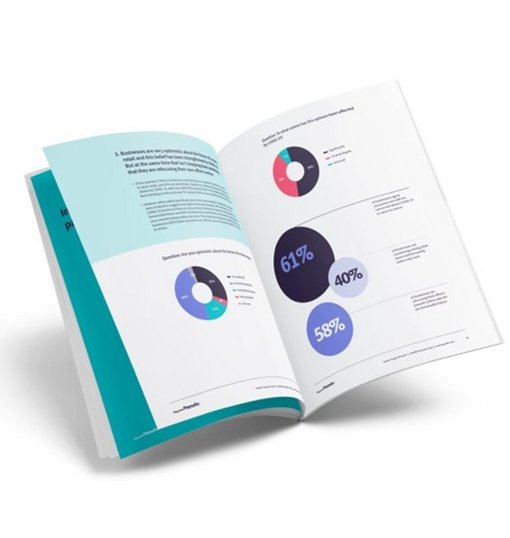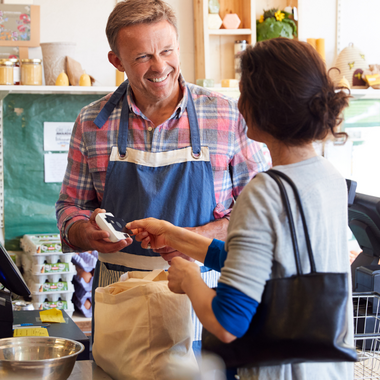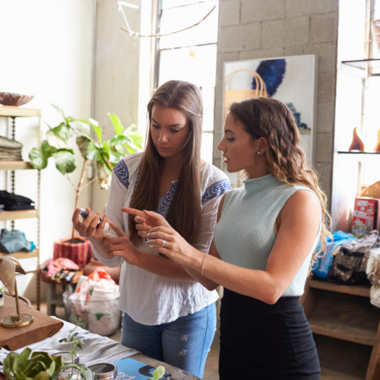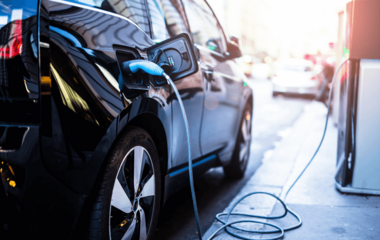
How COVID-19 has reshaped the SMB checkout: In-store
There is a growing gap developing between those in-store businesses that do have an online presence and those that do not, that has been exposed by COVID-19.
1. There is a growing gap developing between those in-store businesses that do have an online presence and those that do not, that has been exposed by COVID-19. Some businesses recognised this during the pandemic and changed tack, and did reap the rewards of this. 38% of in-store businesses said that their volume of business has actually increased due to COVID-19. However, when asked why, only 17% of these businesses said it was due to in-store sales. 19% took orders over the phone, but two thirds (64%) said it was due to an increase in online sales. Of the business that said online sales had boosted their revenue volumes during COVID-19, more than half (38%) launched their online checkout during the pandemic.
Q: To what extent has COVID-19 impacted your volume of business?
Q: Was this increase in business volume due to online sales? (Businesses that saw an increase in sales during COVID-19)
- On the other end of the spectrum, of the 43% of businesses that said their volume had decreased due to COVID-19, 93% say that their volume of business has not rebounded to pre-COVID-19 levels yet, although only 12% say that there has no recovery at all.
Q: Has your volume of business returned to its regular pre-COVID-19 level? (Businesses that saw a drop in sales during COVID-19)
- Overall, almost a quarter (23%) of in-store businesses launched an online checkout since the start of the COVID-19 pandemic and a further 17% plan to do so in the near future. Only 10% of businesses have no plan to have an online presence.
Q: Do you have an online presence?
2. Retailers have worked hard to overhaul their checkout options, and this has had a positive impact on sales. However, businesses still feel as though they weren’t supported enough when trying to make checkout adjustments.
- Only 12% of businesses surveyed said that they had made no adjustment to their checkout offering whatsoever during COVID-19. Among the 88% of business that had introduced changes to their checkout process, the most popular were accepting contactless payments (44%), and accepting card payment on delivery (44%). 35% said that they had integrated a completely new payment method into their checkout.
- Moving away from a physical interaction with a cashier was also popular. 30% of businesses launched online ordering, 28% said that they had launched an app to enable payments without interacting with staff and 18% launched a subscription service.
Q: Which of the following measures have you implemented during COVID-19? Select all that apply.
3. Businesses actually say that they are very optimistic about the future of in-store retail and that this belief has been strengthened by COVID-19. But at the same time that isn’t stopping them admitting that they are refocusing their own efforts online.
- Three quarters (75%) of businesses say that they are optimistic about the future of in-store retail, with 21% say thing that they are pessimistic. Opinions on either side appear to have been driven by their COVID-19 experience, with over half (54%) saying COVID-19 has significantly impacted their thinking on this and only 7% saying COVID-19 has not affected this opinion at all.
Q: Are you optimistic about the future of in-store retail?
- This positivity may been being driven by the surge in panic buying that half (49%) of businesses say that they experienced during the outbreak of the pandemic.
- However, when asked specifically about their own situation, businesses are much more inclined to suggest that online is the way forward. 58% of businesses say COVID-19 has forced them to refocus their businesses towards online sales for the foreseeable future and 40% of businesses say that they are considering closing their store and becoming online only businesses soon. This may be being driven by the fact that most businesses (61%) think consumers are still too concerned about COVID-19 to return to stores and half (50%) say that their customer demographics have changed dramatically due to COVID-19.
- Only 28% of businesses say that they have had no issues with customers using cash throughout COVID-19, with another 4% saying that they were happy to but have been surcharging cash payments. A further 20% of businesses have not stopped accepting cash, but have discouraged customers from using doing so.
- Almost half (47%) of businesses were not accepting cash at some point during the pandemic. A small number (6%) had already stopped accepting cash prior to COVID-19, some (15%) have continued to not accept cash payments having begun this during COVID-19, and others (26%) stopped momentarily but have now started to accept cash again.
Q: Are you currently accepting cash?
- And of those that stopped accepting cash during COVID-19, two thirds (64%) say that they plan to accept cash again in the future. Only 21% say it is their intention to permanently go cashless . However, of those that do accept cash today, almost half (48%) of businesses say they do actually have plans to stop accepting cash.
Q: Assuming COVID-19 is no longer an issue, will you be accepting cash in the future? (to businesses that are not accepting cash currently)
- The vast majority of businesses (83%) already accept contactless payments , and 62% of those that do not have plans to introduce contactless payments.
- There has been a clear surge in the use of contactless payments during COVID-19, perhaps in conjunction with the decreased use of cash. 85% of businesses that accept contactless payments already say the percentage of transactions made with them via contactless has increased during COVID-19, with 44% saying it has increased significantly.
Q: Has the percentage of transactions made via contactless methods in your store increased during COVID-19? (to businesses that do accept contactless payments currently only)
. Reducing friction within the checkout process is a priority for merchants, and they do have plans to integrate evolving technology to make this happen. But they still have concerns about some of these new technologies, as well as other priorities that they are trying to balance when allocating resources.
- Overall, almost two thirds (64%) of businesses say that integrating new technology into their store to enhance the customer experience is a priority for them. The majority (60%) also agree that COVID-19 has resulted in digital transformation being critical to their business surviving and thriving in the future.
- And when asked about customer experience there is a clear focus on the checkout; 54% of businesses say COVID-19 has accelerated their plans to reduce times consumers spend at the checkout and 57% say that reducing the amount of time customers spend at the checkout is their most important concern. Almost half (46%) of businesses say that they have lost customers during COVID-19 because checkout times have been too slow. Overall there is a clear acknowledgement that technology is going to revolutionise the checkout; 47% of businesses agree that the growth of 5G will spell the end of the traditional checkout and 53% say that Amazon-Go style payments where consumers are automatically charged when leaving a store with items is the future of retail.
- But despite this drive to more friction there are still concerns about what this might do to fraudulent transactions; overall 54% of businesses are interested in frictionless transactions e.g. Amazon Go but are worried this will increase the rate of fraudulent transactions. 49% also say COVID-19 has caused a delay of plans to upgrade the checkout as they now have other priorities.
Q: To what extent do you agree with the following statements?
6. Overall, payments appear to be more important to retail merchants now than they have ever been, with COVID-19 having a significant impact on their view of this. And there is definitely scope for payments company to do a better job reacting to this; perhaps for the first-time businesses are starting to think about payments as a competitive advantage rather than just a necessary service.
- For the majority of businesses upgrading their checkout is a current priority and an even greater number of businesses say that this is more of a priority now due to COVID-19. Overall two thirds of businesses agree that COVID-19 has changed the way they think about accepting payments.
- Only 57% of businesses say that their checkout experience currently gives them a competitive advantage.
- When asked about obstacles to upgrading the checkout, 17% of businesses said suppliers do not offer the solution they are looking for and 14% said that they cannot find a supplier that understands their target market.
Q: To what extent do you agree with the following statements?




